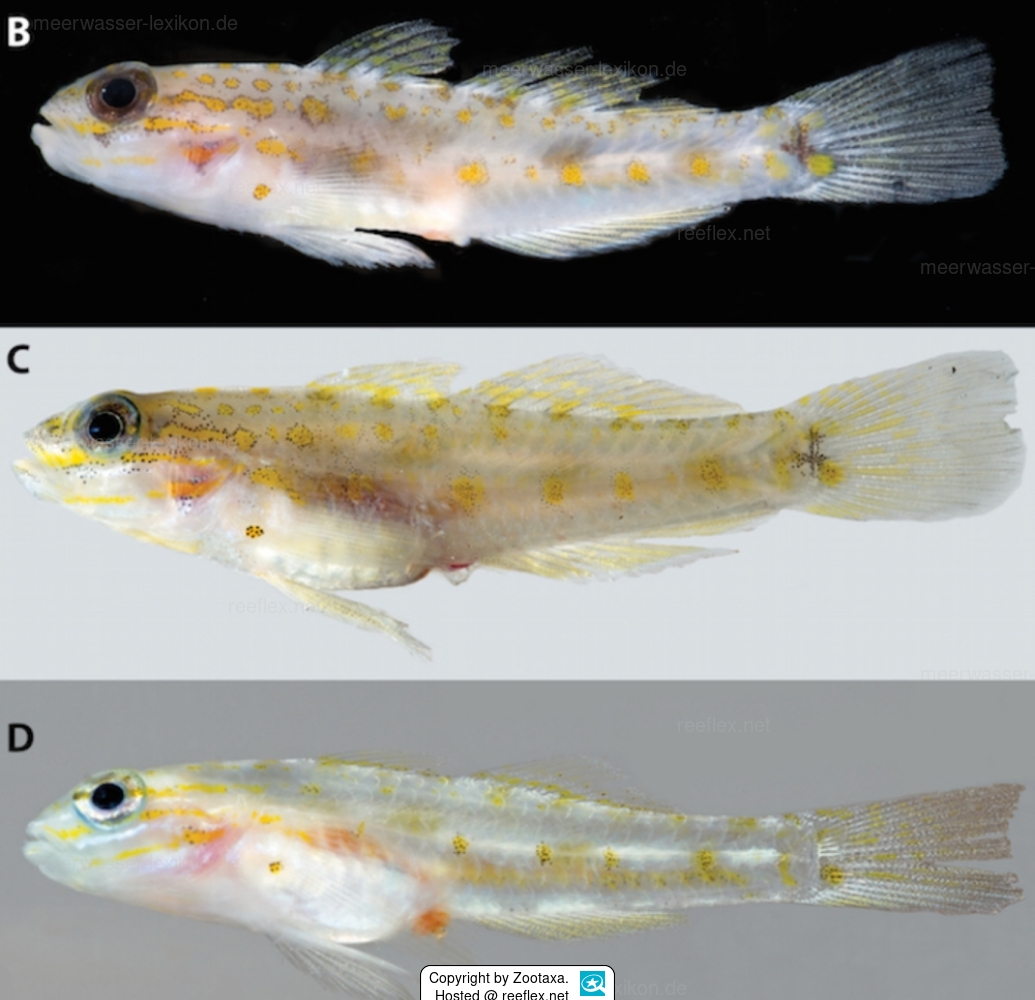Info
Coryphopterus curasub Baldwin & Robertson, 2015
Coryphopterus curasub is the newest species of deepwater reef fish described from the depths of Curacao. The new Coryphopterus goby species is yet another new discovery made by the deep-diving Curasub which now gets its full name included in the binomial designation of the new discovery. The new goby species was collected at a the fully mesophotic depths of 230 to 260 feet using slurpguns on the Curasub.
Gobies of the genus Coryphopterus are mostly found in the western Atlantic ocean and the new ‘Curasub Cory’ is the second such small goby fish to be recently discovered in the depths of Curacao. The other species being the monospecific Antilligobius nikkiae which originally believed to belong to the same Coryphopterus genus.
We don’t have pictures of fresh living specimens, either in an aquarium or in their natural habitat, but the images do reveal a subtly attractive goby with a pattern of yellow spots and facial stripes on a light colored body. Like the closely related masked goby, C. curasub is a diminutive fish growing to just over an inch in length. [ZooKeys]
Original description
Baldwin, C. C.; Robertson, D. R. (2015). A new, mesophotic Coryphopterus goby (Teleostei, Gobiidae) from the southern Caribbean, with comments on relationships and depth distributions within the genus. ZooKeys.
Jumping guard
A jumping guard prevents (nocturnal) fish from jumping out.
Wrasses, blennies, hawkfishs and gobies jump out of an unprotected tank in fright if their night rest is disturbed, unfortunately these jumpers are found dried up in the morning on carpets, glass edges or later behind the tank.
https://www.korallenriff.de/en/article/1925_5_Jump_Protection_Solutions_for_Fish_in_the_Aquarium__5_Net_Covers.html
A small night light also helps, as it provides the fish with a means of orientation in the dark!
Coryphopterus curasub is the newest species of deepwater reef fish described from the depths of Curacao. The new Coryphopterus goby species is yet another new discovery made by the deep-diving Curasub which now gets its full name included in the binomial designation of the new discovery. The new goby species was collected at a the fully mesophotic depths of 230 to 260 feet using slurpguns on the Curasub.
Gobies of the genus Coryphopterus are mostly found in the western Atlantic ocean and the new ‘Curasub Cory’ is the second such small goby fish to be recently discovered in the depths of Curacao. The other species being the monospecific Antilligobius nikkiae which originally believed to belong to the same Coryphopterus genus.
We don’t have pictures of fresh living specimens, either in an aquarium or in their natural habitat, but the images do reveal a subtly attractive goby with a pattern of yellow spots and facial stripes on a light colored body. Like the closely related masked goby, C. curasub is a diminutive fish growing to just over an inch in length. [ZooKeys]
Original description
Baldwin, C. C.; Robertson, D. R. (2015). A new, mesophotic Coryphopterus goby (Teleostei, Gobiidae) from the southern Caribbean, with comments on relationships and depth distributions within the genus. ZooKeys.
Jumping guard
A jumping guard prevents (nocturnal) fish from jumping out.
Wrasses, blennies, hawkfishs and gobies jump out of an unprotected tank in fright if their night rest is disturbed, unfortunately these jumpers are found dried up in the morning on carpets, glass edges or later behind the tank.
https://www.korallenriff.de/en/article/1925_5_Jump_Protection_Solutions_for_Fish_in_the_Aquarium__5_Net_Covers.html
A small night light also helps, as it provides the fish with a means of orientation in the dark!







 Zootaxa
Zootaxa














